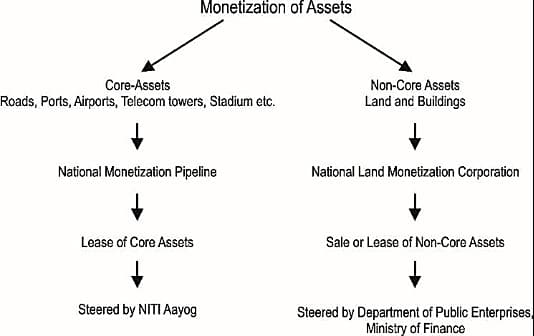Context: The Central Government is preparing to launch Phase II of the National Monetisation Pipeline (NMP) with an ambitious asset monetisation target of Rs 10 lakh crore over 5 years (FY26-FY30).
What is Asset Monetisation?
1. Definition
Asset Monetisation refers to the transfer of core, revenue-generating public assets to the private sector for a limited period.
This process is conducted without transferring ownership — the government retains ownership, while the private entity gets operational control for the duration of the contract.
2. Purpose
To unlock the value of underutilised or operational public assets.
The private sector is expected to bring in efficiency, investment, and innovation in managing the assets.
3. Capital Recycling
The government uses the proceeds from asset monetisation to:
Fund new infrastructure projects
Avoid additional public debt
This approach is known as capital recycling — i.e., using value from old/existing assets to build new infrastructure.
4. Key Features
No sale of public assets — only time-bound leasing or concession agreements.
Covers sectors like roads, railways, airports, ports, power, telecom, and warehousing.

National Monetisation Pipeline (NMP)
Initiative of:
NITI Aayog, in collaboration with the Ministry of Finance
NMP 1.0 (Phase 1: FY22 – FY25)
1. Objective
Raise ₹6 lakh crore through monetisation of core infrastructure assets.
2. Achievements
₹5.65 lakh crore raised (approx. 94% of the target achieved by FY25).
3. Scope
Monetisation limited to core assets — assets central to the government’s business operations.
Core sectors included:
Roads
Railways
Ports
Airports
Telecom
Power (generation & transmission)
Energy pipelines
Warehousing
Hospitality and sports stadiums
4. Exclusions
Non-core assets such as land and government buildings were not included in NMP 1.0.
NMP 2.0 (Phase 2: FY26 – FY30)
1. Target
₹10 lakh crore to be raised over 5 years.
FY26 target: ₹1.9 – 2 lakh crore.
2. Expanded Asset Base
Monetisation to cover:
Highways
Railways
Power (generation & transmission)
Petroleum and Natural Gas
Civil Aviation
Ports
Warehousing and Storage
Urban Infrastructure (housing, transport)
Coal and Mines
Telecom
3. New Focus Area
Vacant public land development through Public-Private Partnerships (PPPs).
Private partners may:
Develop land for infrastructure (e.g., housing, logistics, industrial parks)
Generate long-term revenue streams
4. Role of Consultants
A consultant will be appointed to:
Identify monetisable assets and land parcels
Estimate revenue/investment potential
Propose innovative PPP models for faster infrastructure delivery
5. Monetisation Mechanisms
Upfront lease revenues
Revenue-sharing models
Private sector capital expenditure and investments
